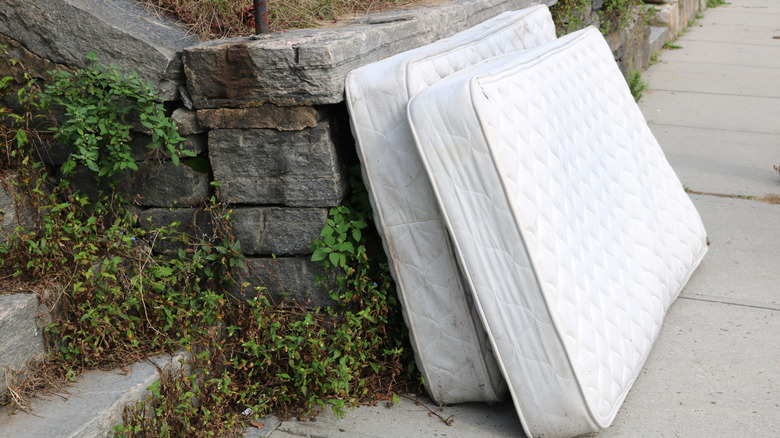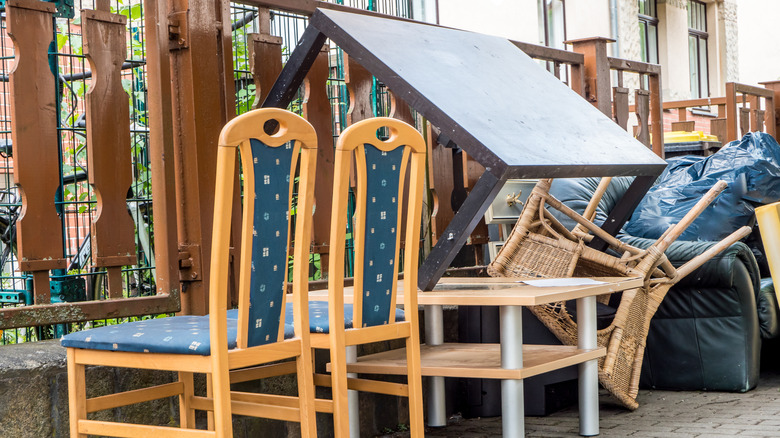Street Finds To Avoid Picking Up For Your Home
Stumbling upon free stuff is always a test of willpower. It can be difficult to differentiate between a want and a need when things come at no cost to you. Decision-making also becomes much harder when you see a free item that has been sitting outside, where anyone can take it. It becomes a split-second decision. Do you leave it be and run the risk of someone else grabbing it while you think things through? Or, do you act fast and take a chance? After all, it's tough to resist the allure of free home items. It's just sitting there, with no strings attached, right?
Wrong. After all, there are many reasons why furniture is the least recycled household object. You may be accidentally inviting bugs, bacteria, and other toxins into your home. It is possible to integrate certain free furnishings into your home safely, but only if you think things through. Here are the most common problems with street finds, and how to tread with caution.
Abandoned mattresses could harbor ecosystems
When stumbling across a discarded mattress, choose wisely, because bed bugs and mold are possible inhabitants. An infestation of either one of these will ruin more than just your sleep. Within days, bed bugs can spread around your house. Then, the problem would likely worsen until you hire an exterminator. The easiest thing to do with a free mattress is just to save yourself the trouble and leave it behind.
If you are curious, you can inspect the mattress closely for rips, tears, and stains. These are a few telltale signs that the mattress is old and in bad shape. However, maybe you've come across a mattress that's wrapped in plastic, and there's no visible damage. Then, you should still be extra careful before bringing it into your home. Use a flashlight to look closely for live bugs and dark spots. If you do not find any, you may want to leave it outside for a few days and slip some bed bug traps under the plastic to detect an infestation before bringing it inside.
Wooden furniture could harbor issues
A tossed-out wooden table or chairs may be a deceptively simple grab. After all, you would think that what you see is what you get. However, you could be setting yourself up for failure. Wooden tables in particular come with a high risk of termites, which can wreak havoc on your home. Wood can also harbor mold, especially if there are a lot of nooks and crannies. Plus, without knowing the origins of the piece, you have no way to verify if it was made with toxic finishes or varnishes.
If a discarded table has little to no cosmetic damage and you are really wanting to snag it, make sure to check it carefully for termite damage. Look closely for any small holes or insect wings and droppings. Then, check all of the visible surfaces for mold or mildew. If there is no mold or bug present, diligently wipe the table down with a cleaning solution designed for wood before bringing it into your home.
Couches always have history
Getting rid of a used couch is such a hassle that many opt to simply dump them outside. Before you pick up that free couch, remember that people spill food, drinks, and worse. Everyone has different hygiene standards, and yours are likely different than the previous owners. You also run the risk of inviting spiders, cockroaches, and other bugs to your home. Be extra cautious if you have any pet allergies, because it is possible that your new free couch may be covered in fur.
First, do a precursory search of the couch, looking closely for stains, tears, mold, and pests. Even if the couch passes the eye test, you should still clean it thoroughly before bringing it into your house. Vacuum each part of the couch, even under the cushions. Then, be sure to use a steam cleaner in every area, making multiple passes to ensure maximum cleanliness. Then, wipe it down carefully with a microfiber cloth and then use sanitizing spray to finish the job.
Technology holds many secrets
Old technology is notorious for harboring bug life, notably roaches. Another risk of unfamiliar technology is fire hazards. Old light fixtures, hair dryers, and appliances with faulty or damaged wires could cause a short circuit in your home. Electronics in particular are tricky because most damage will be interior due to its small, sensitive components. Err on the side of caution, especially with cooking equipment and anything else that has a heating element.
With any piece of street technology, you should wipe it down thoroughly and inspect all wires before plugging it in. You can also use a can of compressed air to make sure there's nothing lingering in the vents. With bigger devices like printers and computer components, make sure to open every panel to check for bugs. If there are no signs of infestation and no visible damage, watch it carefully for overheating or smoking after plugging it in.
Plants can get your other fauna sick
Bringing new plants into your home risks more than just an infestation. New plants come with the risk of infecting your other plants with diseases. If you really want that free plant, first you should make sure you know what kind of plant it is so you're fully prepared to take care of it. Some plants are more demanding than others, and you should only take it if you can give it the attention it deserves.
Crucially, every area of your new plant should be inspected for pests, down to the roots. Check for discoloration and signs of infections. If everything looks good, replant it in a pot with new dirt and isolate it for a few days. Check on it regularly to make sure there are no issues or new symptoms. Make sure to wash your hands thoroughly every time you touch the new plant. After four or five days without issue, it should be safe to move in with the others. If you find any signs to the contrary, remove the plant from your household immediately.
Books may introduce silverfish
You would not expect to encounter any risks when picking up secondhand books, but here we are. Little free libraries are a recipe for bringing home silverfish infestations. The insects love the dark, unused thin cavities of old books because they can eat the glue that binds the pages together. These can cause your book collection to fall apart even when you have not been reading. A telltale sign of a silverfish infestation is small, yellow stains on pages.
The easiest way to get rid of silverfish is to sprinkle natural dust insecticides, which are odorless, onto your secondhand books. You can use diatomaceous earth to eliminate them without using toxins. Silverfish are also biologically opposed to any sort of acidity, so they can be drawn out of hiding with lemon or orange peels. Chop up some of the citrus fruits, and soak the peels in warm alcohol overnight. Then, put the concoction in a spray bottle, and take the books outside. Apply it to the covers and several pages, spraying it lightly so you don't damage the books.
Rugs hide a bunch of bacteria
Used rugs, which are a popular household item to recycle, are notoriously difficult to clean. So difficult, in fact, that they are not actually free. The bacterial contents of old rugs hide in plain sight because mold and mildew can blend right into rug patterns. Plus, they can be homes to pests like fleas and bed bugs that you certainly don't want hitching a ride into your home. So, you may need a professional to clean them properly, which may cost up to $600, just as much as a new rug.
If you see a used rug that you just have to have, dust it off and store it somewhere safe outside until you can have it cleaned. Wash your hands after touching it and make sure not to walk on it barefoot until after it's clean and dry. Professional rug cleanings typically use strong non-toxic chemicals, and they are so thorough that you will immediately see and smell the difference.







